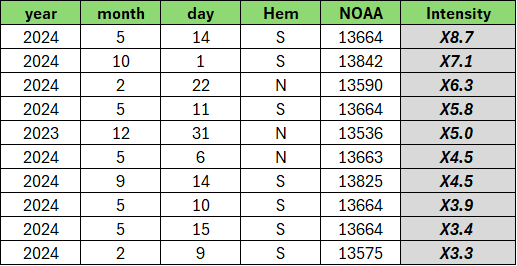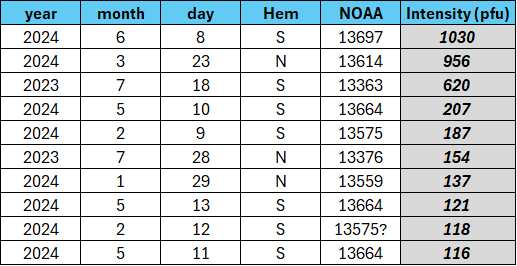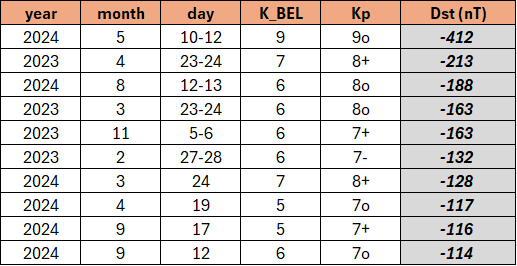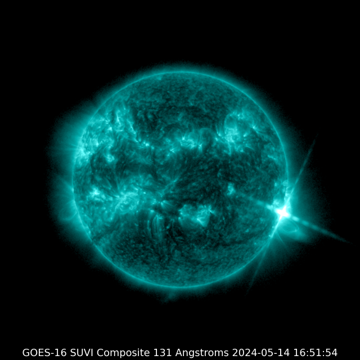Solar activity is now passing through the phase of solar cycle maximum. So, it would be good to have an idea on how strong this solar cycle (SC25) has been in terms of intensity of solar flares, proton events and geomagnetic storms. The data period runs up to 1 October.

The strongest solar flare so far during SC25, so up to 1 October, was an X8.7 flare produced by famous sunspot region NOAA 13664 on 14 May 2024 (see this STCE newsitem). This active region has 4 entries in the Top 10 of strongest flares, as shown in the table above. It is very likely that even stronger flares have been produced but on the Sun's far side, as observed by instruments on board of Solar Orbiter. Examples are on 20 May and on 22 July 2024, when intensities of X12 and X14 may have been reached. For comparison purposes, the strongest flare observed in the GOES-era was the X40 flare (rescaled) that occurred on 4 November 2003.

So far this solar cycle, the Sun has produced about 2 dozen of minor proton events, i.e. when the larger than 10 MeV proton flux reached values between 10 and 100 pfu. Another 10 proton events have exceeded 100 pfu, and of those only one exceeded 1000 pfu. So the strongest proton event so far (1030 pfu) took place on 8 June 2024 and was related to an M9 flare produced by active region NOAA 13697, which was the return of NOAA 13664. Two proton events have been associated to a minor Ground Level Enhancement (GLE), i.e. when the secondary particles from these proton events were measured by ground based neutron detectors. This was on 28 October 2021 and on 11 May 2024. For reference, the previous solar cycle had no GLEs, but the strongest proton event reached a peak of 6530 pfu (8 March 2012). The largest proton event during the GOES-era so far was on 23-24 March 1991 (43.000 pfu).

As far as geomagnetic storms goes, it's no surprize that the strongest storm was the famous event from 10-12 May earlier this year (see this STCE newsitem). The table above ranks the geomagnetic disturbances according to the Dst index (provisional values; expressed in nT; the more negative, the stronger the storm ; Kyoto WDC). After the -412 nT of the May 2024 storm, the intensity of the geomagnetic storms in the list drops off quickly with -so far- only one more storm with a Dst smaller than -200 nT and only 3 with intensities between -150 and -200 nT. As a reference, the geomagnetic storm of 13-14 March 1989 had a Dst of -589 nT, and the 20 November 2003 storm reached -422 nT. The table also mentions the corresponding Kp index as well as the local K index for Belgium (K_BEL).

Though we are now at solar cycle maximum and gradually may see a gentle decrease in sunspot numbers and solar flare, we may still expect strong space weather storms. Indeed, the strongest flares and geomagnetic storms usually seem to occur 2-3 years after solar cycle maximum, such as e.g. in 2003 and 2005 during SC23 and 2015 and 2017 during SC24. And because we basically haven't seen any strong proton event, it's almost certain we can still expect a really strong proton event (5000 pfu or larger) in the next few years. So it may be wise to keep that umbrella nearby, we may still need it!





